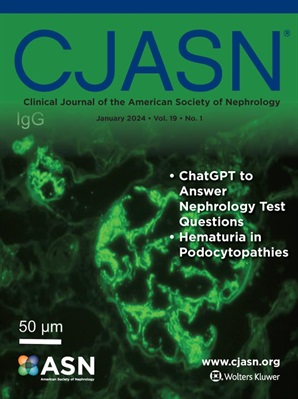长透析间隔期后心血管功能异常反应:一项准实验交叉研究
IF 8.5
1区 医学
Q1 UROLOGY & NEPHROLOGY
Clinical Journal of the American Society of Nephrology
Pub Date : 2025-06-09
DOI:10.2215/cjn.0000000749
引用次数: 0
摘要
通过心肺运动试验(CPET)评估短、长透析间隔后的功能反应模式。方法:我们进行了一项探索性的单中心、准实验的两组研究,包括对常规每周三次维持性HD患者的治疗顺序进行交叉。所有患者在透析间隔2天和3天结束时,分别在hd后和hd前三次研究访问中接受CPET、生物电阻抗谱和身体功能测试。结果:31例患者(N=19名男性,平均[SD]年龄55(12)岁,中位[IQR]透析时间56[24,96]个月)完成了所有研究访问。透析间期体重增加和总体液在透析3天后大于透析2天后(P <0.001)。通气/二氧化碳生成(VE/VCO2)斜率是运动时肺血管阻力和右心室(RV)功能障碍的无创指标,在3天后显著升高(31.2 (4.8)L VE/L VCO2;P=0.002)与2天相比(29.5 (3.9)L VE/L VCO2)。两组间的摄氧量峰值(VO2Peak)和无氧阈值VO2无显著差异。两天至三天VE/VCO2斜率(ΔVE/VCO2)变化(Δ)与Δbody体重(r=0.36, P=0.04)和左心室质量指数(r=0.44, P=0.02)相关。结论:较长的透析间期与异常的运动性通气和血流动力学反应有关,包括运动期间通气-灌注错配和潜在的右心室功能障碍以及右心室-肺动脉解耦,这与升高的VE/VCO2斜率有关。版权所有©2025 by美国肾脏学会…本文章由计算机程序翻译,如有差异,请以英文原文为准。
Abnormal Cardiovascular Functional Responses After the Long Interdialytic Interval: A Quasi-Experimental Crossover Study
ctional response patterns, as assessed by cardiopulmonary exercise testing (CPET), following the short- and long- interdialytic intervals. Methods: We conducted an exploratory single center, quasi-experimental two-arm study involving crossover of treatment sequences in patients on conventional thrice-weekly maintenance HD. All patients underwent CPET, bioelectrical impedance spectroscopy, and physical function testing on three study visits: Post-HD, and Pre-HD at the end of a two-day and the three-day interdialytic intervals. Results: Thirty-one patients (N=19 men, mean [SD] age 55 (12) years, median [IQR] dialysis vintage 56 [24, 96] months) completed all study visits. Interdialytic weight gain and total body fluid were greater following three-day compared with two-day (P <0.001). Ventilation/carbon dioxide production (VE/VCO2) slope, a non-invasive index of exercise pulmonary vascular resistance and right ventricular (RV) dysfunction, was significantly elevated at three-day (31.2 (4.8) L VE/L VCO2; P=0.002) compared with two-day (29.5 (3.9) L VE/L VCO2). No significant differences between interdialytic intervals were observed for peak oxygen uptake (VO2Peak) or VO2 at the anaerobic threshold. Change (Δ) in VE/VCO2 slope (ΔVE/VCO2) from two-day to three-day was correlated with Δbody weight (r=0.36, P=0.04) and left ventricular mass index (r=0.44, P=0.02). Conclusions: The long interdialytic interval is associated with abnormal exercise-derived ventilatory and hemodynamic responses, including ventilation-perfusion mismatch and potentially RV dysfunction and RV–pulmonary artery uncoupling during exercise as suggested by elevated VE/VCO2 slope. Copyright © 2025 by the American Society of Nephrology...
求助全文
通过发布文献求助,成功后即可免费获取论文全文。
去求助
来源期刊
CiteScore
12.20
自引率
3.10%
发文量
514
审稿时长
3-6 weeks
期刊介绍:
The Clinical Journal of the American Society of Nephrology strives to establish itself as the foremost authority in communicating and influencing advances in clinical nephrology by (1) swiftly and effectively disseminating pivotal developments in clinical and translational research in nephrology, encompassing innovations in research methods and care delivery; (2) providing context for these advances in relation to future research directions and patient care; and (3) becoming a key voice on issues with potential implications for the clinical practice of nephrology, particularly within the United States. Original manuscript topics cover a range of areas, including Acid/Base and Electrolyte Disorders, Acute Kidney Injury and ICU Nephrology, Chronic Kidney Disease, Clinical Nephrology, Cystic Kidney Disease, Diabetes and the Kidney, Genetics, Geriatric and Palliative Nephrology, Glomerular and Tubulointerstitial Diseases, Hypertension, Maintenance Dialysis, Mineral Metabolism, Nephrolithiasis, and Transplantation.

 求助内容:
求助内容: 应助结果提醒方式:
应助结果提醒方式:


